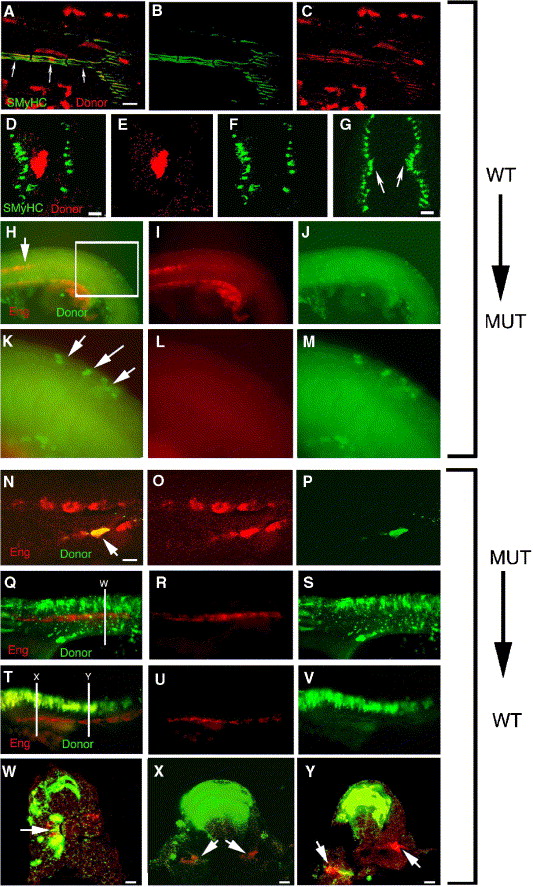Fig. 5 Non-cell autonomous somitic requirement for the gene encoded by the you locus in myotomal cell fate determination. (A?M) Transplantation of wildtype blastula cells into homozygous mutant youty97 host embryos. (A) Rhodamine dextran labelled donor cells (red) transplanted into a homozygous youty97 host embryo targeted to posterior, tail extension somites, rescues formation of both muscle pioneer cells (arrows) and slow MyHC expression (green). (B) Slow MyHC protein (SMyHC) expression (green) is rescued by transplantation of wild type cells. (C) Position of transplanted clones is revealed by Rhodamine dextran. (D?G) Cross sections at the level of yolk extension myotomes revealing that transplantation of wild type cells (red) in the notochord of a homozygous youty97 mutant does not rescue muscle pioneer and slow muscle formation (green). (D) Slow MyHC in green, wildtype donor cells in red. (E) Wildtype donor cells (red) only. (F) Slow MyHC staining (green) only. (G) A wild type embryo sectioned at a similar level stained for slow MyHC (green) is shown for comparison. The presence of muscle pioneers is indicated by arrows. (H?J) Transplantation of wildtype donor cells (green) into the most dorsal aspect of the neural tube of a homozygous mutant youty97 mutant embryos cannot rescue the formation of engrailed (eng) expressing muscle cells, as revealed by in situ hybridisation with an antisense probe against the eng1 gene, a marker of muscle pioneer formation, utilising the Fast Red (Roche) fluorescent substrate (red). (H) Eng-expressing cells (red) and wildtype donor cells (green). (I) Eng staining (red) only. (J) wildtype donor cells (green) only. (K?M) High magnification view of the region boxed in panel H. The arrows in panel K mark the site of the donor cells. (L) Note the lack of eng expression in somites adjacent to the transplanted cells (M). (N?Y) Transplantation of homozygous youty97 mutant blastula cells into wild type host embryos. (N?P) Dorsal views anterior to the left. A single mutant cell transplanted into the region of the yolk extension somites of a wildtype host can differentiate as an eng (red) expressing muscle pioneer cell, revealing a non-autonomous action of the you gene product. Panel N. Overlay of Eng staining (red) and donor staining (green). (O) Eng staining (red) only. (P) Donor cell staining (green) only. (Q?Y) Transplantation of mutant cells (green) into the neural tube of wild type host embryos does not disrupt muscle pioneer formation (red). (Q?V) Low magnification lateral views, anterior to the left, of yolk extension somites in transplanted hosts showing a high level of chimerism. Vertical lines denote the corresponding sections, panels W?Y. (Q and T) Overlay of eng staining (red) and donor staining (green). Panels R and U. eng staining (red) only. Panels S and V. donor cell staining (green) only. Panel W. Cross-section revealing the contribution of mutant donor cells to engrailed positive muscle pioneer cells (arrows). Note also that transplanted cells in the dorsal neural tube fail to interfere with muscle pioneer formation. (X, Y) Engrailed positive myocytes (arrows) still form even when mutant cells comprise the entire dorsal aspect of the neural tube. Scale bars, 20 μM. WT?wildtype, MUT?youty97 homozygous mutant.
Reprinted from Developmental Biology, 294(1), Hollway, G.E., Maule, J., Gautier, P., Evans, T.M., Keenan, D.G., Lohs, C., Fischer, D., Wicking, C., and Currie, P.D., Scube2 mediates Hedgehog signalling in the zebrafish embryo, 104-118, Copyright (2006) with permission from Elsevier. Full text @ Dev. Biol.

